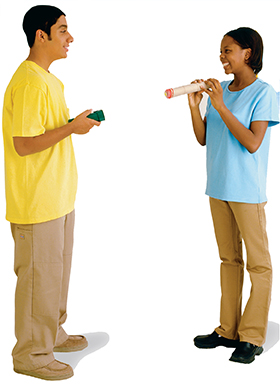Part B: Investigating How Frequency Affects Pitch and How Amplitude Affects Loudness
Cut the neck off of the balloon. Replace the wax paper on the longer kazoo with the cut-open balloon. Wrap the rubber band several times around the end of the cardboard tube. The rubber band should hold the balloon tightly stretched over the end of the tube. Use tape to attach the small mirror onto the balloon on the end of the tube.
Have a classmate shine a flashlight on the mirror as shown while you hum into the kazoo. Your classmate should position the flashlight so that a spot of light is reflected on the wall. It may be necessary to darken the room. Observe how the spot of light moves when you hum into the kazoo. Make a note of your position and the position and angle of the kazoo and the flashlight.
Without changing how loudly you hum, use your voice to raise the pitch of your humming. Observe and record how the movement of the spot of light differs from your observations in Step 8. Make sure you do not change your distance from the wall or the angle at which the light from the flashlight strikes the mirror attached to the kazoo.
Repeat Step 9, but this time hum at a lower pitch than you did in Step 8.
Repeat Steps 9 and 10, but this time vary the loudness of your humming while keeping the pitch constant.
Analyze and Conclude
Observing What happened to the frequency of the meter stick's vibration when you made the overhanging part longer?
Inferring How did the frequency of the meter stick's vibration affect the pitch of its sound?
Inferring How did the kazoo's length affect its pitch?
Analyzing Data When you changed the pitch of your humming, how did it affect the frequency of vibration of the mirror?

Analyzing Data How is the amplitude of the kazoo's vibration related to its loudness?
Controlling Variables Explain why it was important to keep loudness constant when you changed the pitch of your humming in Step 9.
Go Further
Design an experiment to investigate what variables affect the pitch and loudness of vibrating strings. Use an instrument such as a guitar or violin. After your teacher approves your plan, carry out your experiment.




